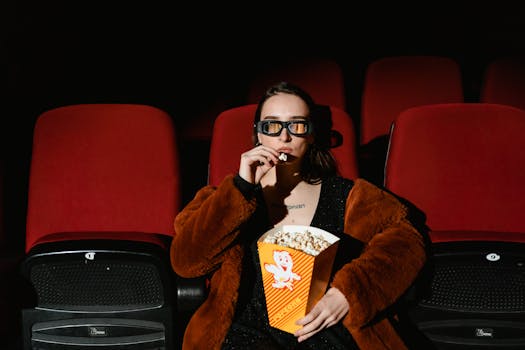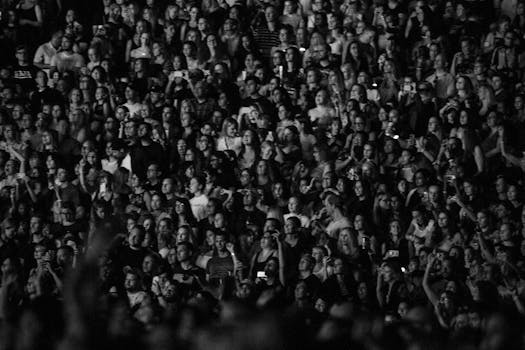Movies
How Indie Films Found Their Place in Hollywood
Dive into the story of how indie films reshaped Hollywood. Discover their authentic voices, bold storytelling, and creative journey to critical acclaim and lasting impact.
Advertisement
Most moviegoers connect Hollywood with blockbuster spectacles, but many might be surprised by how indie films quietly shaped the industry from the margins. These lower-budget films have snuck into the mainstream with fresh perspectives, vivid characters, and bold storytelling decisions.
Cinema thrives on variety and risk, which is why the evolution of indie films matters well beyond film buffs. Their ability to innovate voices, break narratives, and spotlight new talent has reshaped expectations for what movies can be.
This article peels back how indie films carved out space in Hollywood, changed filmmaking culture, and continue setting the bar higher. Keep reading for real strategies and relatable stories behind the indie film movement’s lasting impact.
Indie Films Take Root: Creating Authentic Voices on Screen
New directors began making indie films from necessity, not just choice, so they found ways to tell stories with limited means. Each film stood out not for budget, but for sincerity and a personal touch.
Audiences connected with these distinct voices because they saw real people, not just polished stars. This helped indie films quietly stake a claim in a landscape once ruled by major studios.
Adapting Everyday Obstacles for Screen Impact
Savvy indie filmmakers often worked with shoestring budgets, learning how to stage scenes in friends’ apartments or vacant lots. Each challenge forced inventiveness, encouraging tight storytelling and clever visuals that big-budget films might overlook.
When equipment went missing or funds ran low, teams improvised with smartphones, borrowed gear, or natural lighting. Their creativity wasn’t just a result of resourcefulness, but a deliberate adaptation to make the story shine.
Filmmakers like Greta Gerwig and Barry Jenkins used these constraints to create films with a lived-in, raw tone. Their approach made every scene feel direct and unfiltered.
Genuine Casting Elevates Relatable Characters
Indie films often cast new or non-professional actors, so characters felt relatable. Audiences saw actors express realistic emotions—awkwardness, doubt, hope—mirroring daily life rather than Hollywood fantasy.
Directors would rehearse with actors in casual conversations before filming, letting them build chemistry naturally. On set, they’d say, “Just relax, talk like you’re at home,” to draw out subtle, human performances.
This grounding in authenticity allowed viewers to become immersed in the film’s world, investing in characters who didn’t look or sound rehearsed. Authenticity became the signature of indie cinema’s rising appeal.
| Indie Film | Budget | Main Theme | Unique Feature | Action Step |
|---|---|---|---|---|
| Moonlight | $1.5 million | Identity | Intimate storytelling | Study personal storytelling for deeper drama |
| Lady Bird | $10 million | Coming-of-age | Natural dialogue | Write dialogue that feels spoken, not scripted |
| The Blair Witch Project | $60,000 | Horror | Found-footage style | Use constraints to fuel creativity |
| Reservoir Dogs | $1.2 million | Crime | Conversational tension | Build suspense through conversations |
| Little Miss Sunshine | $8 million | Family, Road trip | Realistic dysfunction | Ground comedy in relatable setbacks |
Tactics for Breaking Through Hollywood’s Wall
Catching studio attention meant that indie films had to stand apart right from the pitch. Their teams focused on telling compelling stories that could spark conversation after a single viewing.
Filmmakers who wanted a shot at wider release prepared strong festival strategies and sharpened their networking as much as their scripts, increasing the odds of discovery.
Building Buzz on the Festival Circuit
Sundance, Cannes, and Toronto became launchpads for indie films seeking exposure. Festival acceptance carried legitimacy, drawing press and buyers looking for the next sleeper hit.
Directors would rehearse short, punchy pitches for festival conversations: “My film is about a quiet kid wrestling with guilt.” Meetings relied on authenticity and clear vision over flashy selling points.
- Submit film early to more festivals: More entries mean more chances, especially for smaller, competitive events.
- Prepare a compact pitch: Highlight what’s unique in 30 seconds to stand out during quick networking encounters.
- Network at screenings: Attend Q&As, shake hands, and discuss filmmaking, not just your project, to build organic relationships.
- Leverage social media: Document the journey, share behind-the-scenes clips, and interact genuinely with audiences for visible buzz.
- Recruit festival alumni as mentors: Their insights shorten your learning curve for submissions and pitches.
Each success at a renowned festival multiplied word-of-mouth, paving the way for distribution deals and acclaim.
Leveraging Partnerships for Indie Growth
Some indie filmmakers worked directly with grassroots cinema chains or local film societies. These partnerships nurtured communities while offering affordable screening space and publicity.
Crowdfunding platforms let filmmakers pitch directly to future fans. They’d share pitch videos, production diaries, or rough cuts to create a sense of involvement and urgency.
- Host local preview events: Test content, spark buzz, and collect feedback from potential supporters in the community to refine the finished film.
- Share production progress openly: Regular updates build a story around the film itself, boosting audience anticipation before release.
- Offer creative rewards for support: Incentivize backers with set visits, signed memorabilia, or exclusive early previews that make them feel part of the team.
- Collaborate with small businesses: Tie screenings to local coffee shops or bookstores, attracting overlapping audiences and media coverage.
- Develop authentic partnerships: Choose partners who genuinely value indie films and support creative risks, not just sales.
Collaboration strengthened the roots of the indie film community, fostering growth through practical action rather than expensive promotion.
Building Momentum: Public Demand for Authentic Cinema
Widespread craving for original content turned attention toward indie films that defied easy genre labels. Their honesty won over skeptical audiences for whom formulaic blockbusters felt stale and remote.
Word-of-Mouth Campaigns and Cult Status
Movies like “The Blair Witch Project” and “Napoleon Dynamite” leaned into grassroots campaigns, inspiring viewers to champion films they loved. Social media amplified these campaigns with shareable memes, GIFs, or quirky in-jokes.
Friends would say, “You have to see this movie; it’s so odd and real.” Such recommendations heated up public curiosity far beyond traditional advertising reach, building cult status steadily over months.
Eventually, word-of-mouth became a reliable tool for indie film success, helping them stand out even as Hollywood tried to adapt or imitate their methods.
Indie Films Branch Into Streaming and VOD
Video-on-demand platforms gave indie films direct pipelines to curious viewers who didn’t live near specialty cinemas. Instead of wide theatrical releases, filmmakers could prioritize impact with targeted streaming launches.
Audiences seeking variety would scroll past the big-budget titles and purposefully stop at indie films, drawn by their honest trailers and niche appeal. This access redefined the audience connection with unique storytelling.
With global reach suddenly achievable from a laptop, indie filmmakers found new incentive to take creative risks, secure that their films could still find supporters worldwide.
Dividing Lines Blur: Major Studios Adopt Indie Tactics
Studios took notice when indie films gained traction. Soon, these companies pursued smaller projects and even created boutique divisions to capitalize on the organic appeal of indie cinema.
This crossover created both opportunity and tension: while indies gained resources, they risked losing their edge if forced to over-polish for mass markets. Navigating this mix became its own craft.
Studio-Backed Indie Successes
Companies launched specialty labels to nurture “independent-style” stories—think Fox Searchlight or Focus Features. They offered funding without imposing conventional templates, encouraging a hybrid model blending support with creative freedom.
Filmmakers suddenly had backing for risky narratives and emotionally honest scripts that felt indie but came with marketing muscle. This let directors experiment without the uncertainty of full independence.
When “Juno” or “Little Miss Sunshine” won awards, audiences and studios saw that personal vision could move mainstream viewers, not just art-house fans.
Creative Compromise and Preserving Vision
Occasionally, the studio influence led to friction. Some filmmakers adjusted scripts or casting in order to secure final funding. When done with selectivity, this compromise didn’t dilute the film’s voice.
Directors who preserved their vision usually clarified non-negotiables early: “Character X must stay flawed,” or “No Hollywood ending.” This clear goal led to smoother negotiations and better films.
By using contracts and honest communication, indie storytellers could retain what made their films unique, even while partnering with large brands.
The Continual Rise of Indie Films in Cinematic Storytelling
The journey of indie films—from scrappy outsiders to celebrated highlights of Hollywood—demonstrates how originality and resilience redefine opportunity. Their innovative approaches, community-driven tactics, and authentic performances remain essential in an evolving industry.
Indie films never allowed budget or connections to stand in the way. Instead, they leaned into resourcefulness, heartfelt storytelling, and audience connection. These methods have changed what viewers expect and how future films will be made.
The ongoing success of indie films proves that cinema is healthiest when it encourages new voices, tackles real issues, and welcomes stories told without compromise. Their determination keeps the landscape unpredictable, open, and always evolving.
Trending Topics

How Costume Choices Define a Character’s Story: The Impact of Costume Design Film
Learn how costume design in film defines identity, builds emotion, and visually tells a character’s evolution through every scene.
Keep ReadingYou may also like

Hidden Movie Endings That Completely Change the Story
Discover hidden movie endings that completely shift meaning, twist expectations, and make audiences rethink the story’s truth.
Keep Reading


